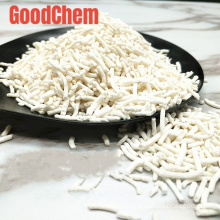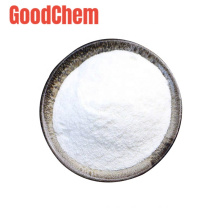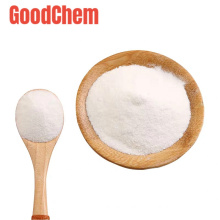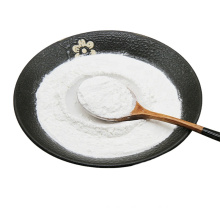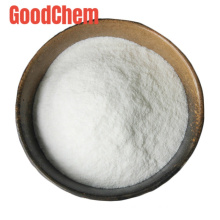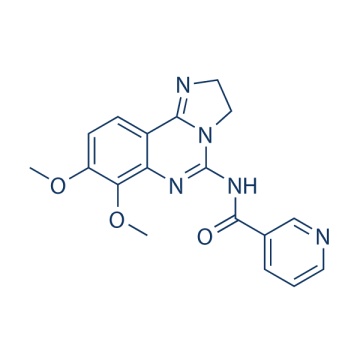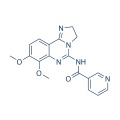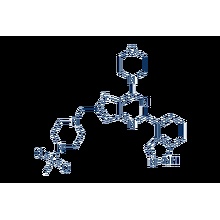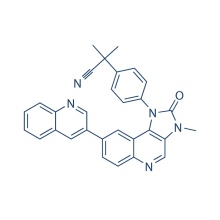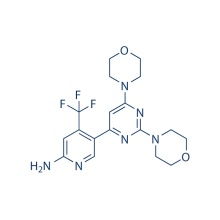.cp_wz table {border-top: 1px solid #ccc; border-left: 1px solid #ccc; } .cp_wz table td {border-right: 1px solid #ccc; borda inferior: 1px sólido #ccc; preenchimento: 5px 0px 0px 5px;} .cp_wz tabela th {border-right: 1px solid #ccc; border-bottom: 1px solid #ccc; preenchimento: 5px 0px 0px 5px;} \ n Peso molecular: 351,36 PIK-90 é um inibidor PI3Kα / γ / δ com IC50 de 11 nM / 18 nM / 58 nM, respectivamente, menos potente para PI3Kβ. \ n PIK-90 mostra padrões distintos de seletividade de isoformas para inibir diferentes subconjuntos de quatro isoformas de PI3K de classe I. Além disso, PIK-90 inibe completamente a fosforilação de Akt estimulada por fMLP e prejudica a polaridade e a quimiotaxia em células dHL60. PIK-90 exibe atividade antiproliferativa significativamente bloqueando eficazmente a fosforilação de Akt em seis linhas celulares de glioma que variam em status mutacional em PTEN ou p53, incluindo células U87 MG, SF188, SF763, LN229, A1207 e LN-Z30. Além disso, PIK-90 induz uma parada modesta de G0G1 a uma concentração (0,5 μM) suficiente para inibir substancialmente a fosforilação de Akt. Em células de leucemia linfocítica crônica (LLC), PIK-90 inibe a quimiotaxia em níveis que são 57,8% dos controles a 1 μM e 56,8% dos controles a 10 μM. Consistentemente, PIK-90 inibe a pseudoemperipolesis a níveis que são 74,2% PIK-90 dos controles a 1 μM e 57,9% dos controles a 10 μM. Além disso, PIK-90 também leva a uma redução significativa da migração de células CLL para a camada de células do estroma e diminui a polimerização de actina induzida por CXCL12. Imediatamente após o tratamento com insulina, PIK-90 (10 mg / kg) protege completamente os animais contra este declínio da glicose no sangue estimulado pela insulina.
|
Expression and Assay of p110α/p85α, p110β/p85α, p110δ/p85α, and p110γ
|
IC50 values are measured using either a standard TLC assay for lipid kinase activity or a high-throughput membrane capture assay. Kinase reactions are performed by preparing a reaction mixture containing kinase, inhibitor (2% DMSO final concentration), buffer (25 mM HEPES, pH 7.4, 10 mM MgCl2), and freshly sonicated phosphatidylinositol (100 μg/mL). Reactions are initiated by the addition of ATP containing 10 μCi of γ-32P-ATP to a final concentration 10 μM or 100 μM, and allowed to proceed for 20 minutes at room temperature. For TLC analysis, reactions are then terminated by the addition of 105 μL 1N HCl followed by 160 μL CHCl3:MeOH (1:1). The biphasic mixture is vortexed, briefly centrifuged, and the organic phase transferred to a new tube using a gel loading pipette tip precoated with CHCl3. This extract is spotted on TLC plates and developed for 3-4 hours in a 65:35 solution of n-propanol:1M acetic acid. The TLC plates are then dried, exposed to a phosphorimager screen, and quantitated. For each compound, kinase activity is typically measured at 10-12 inhibitor concentrations representing two-fold dilutions from the highest concentration tested (100 μM). For compounds showing significant activity, IC50 determinations are repeated two to four times, and the reported value is the average of these independent measurements.
|
Ensaio de células: [2]
|
Cell lines
|
U87 MG, SF188, SF763, LN229, A1207 and LN-Z3 cells
|
|
Concentrations
|
0 to 1 μM
|
|
Incubation Time
|
72 hours
|
|
Method
|
For viabilty, cells are seeded in 12-well plates in the presence of PIK-90 for 3 days. Cell viability is determined using a WST-1 assay.
|
Estudo Animal: [4]
|
Animal Models
|
FVB/N female mice are fasted at 9:00 a.m. and then given human insulin or vehicle (PBS) intravenously at 12:00 p.m.
|
|
Formulation
|
PIK-90 is dissolved in DMSO and then diluted in water.
|
|
Dosages
|
≤10 mg/kg
|
|
Administration
|
Administered via i.p.
|
|
Solubility
|
1% DMSO/30% polyethylene glycol/1% Tween 80, pH 4,
15 mg/mL
|
|
* Please note that Selleck tests the solubility of all compounds in-house, and the actual solubility may differ slightly from published values. This is normal and is due to slight batch-to-batch variations.
|
Conversão de diferentes modelos de animais com base em BSA (valor com base em dados das diretrizes preliminares da FDA)
|
Species
|
Baboon
|
Dog
|
Monkey
|
Rabbit
|
Guinea pig
|
Rat
|
Hamster
|
Mouse
|
|
Weight (kg)
|
12
|
10
|
3
|
1.8
|
0.4
|
0.15
|
0.08
|
0.02
|
|
Body Surface Area (m2)
|
0.6
|
0.5
|
0.24
|
0.15
|
0.05
|
0.025
|
0.02
|
0.007
|
|
Km factor
|
20
|
20
|
12
|
12
|
8
|
6
|
5
|
3
|
|
Animal A (mg/kg) = Animal B (mg/kg) multiplied by
|
Animal B Km
|
|
Animal A Km
|
Por exemplo, para modificar a dose de resveratrol usada para um camundongo (22,4 mg / kg) para uma dose baseada na BSA para um rato, multiplique 22,4 mg / kg pelo fator Km para um camundongo e, em seguida, divida pelo fator Km para um rato. Este cálculo resulta em uma dose equivalente de rato para o resveratrol de 11,2 mg / kg.
|
Rat dose (mg/kg) = mouse dose (22.4 mg/kg) ×
|
mouse Km(3)
|
= 11.2 mg/kg
|
|
rat Km(6)
|
Informação Química
|
Molecular Weight (MW)
|
351.36
|
|
Formula
|
C18H17N5O3
|
|
CAS No.
|
677338-12-4
|
|
Storage
|
3 years -20℃Powder
|
|
6 months-80℃in solvent (DMSO, water, etc.)
|
|
Synonyms
|
|
|
Solubility (25°C) *
|
In vitro
|
DMSO
|
0.28 mg/mL
(
|
|
Water
|
<1 mg/mL
(
|
|
Ethanol
|
<1 mg/mL
(
|
|
In vivo
|
1% DMSO/30% polyethylene glycol/1% Tween 80, pH 4
|
15 mg/mL
|
* <1 mg/ml means slightly soluble or insoluble.
* Please note that Selleck tests the solubility of all compounds in-house, and the actual solubility may differ slightly from published values. This is normal and is due to slight batch-to-batch variations.
|
|
Chemical Name
|
N-(2,3-dihydro-7,8-dimethoxyimidazo[1,2-c]quinazolin-5-yl)-3-pyridinecarboxamide
|
Calculadora de molaridade Calculadora de diluição Calculadora de peso molecular
Grupo de Produto : PI3K / Akt / mTOR > Inibidor PI3K
